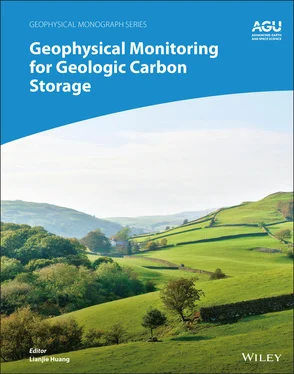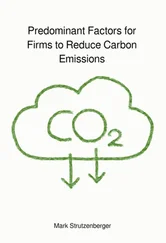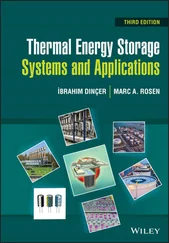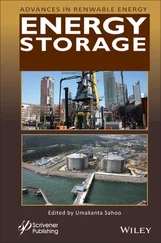Geophysical Monitoring for Geologic Carbon Storage
Здесь есть возможность читать онлайн «Geophysical Monitoring for Geologic Carbon Storage» — ознакомительный отрывок электронной книги совершенно бесплатно, а после прочтения отрывка купить полную версию. В некоторых случаях можно слушать аудио, скачать через торрент в формате fb2 и присутствует краткое содержание. Жанр: unrecognised, на английском языке. Описание произведения, (предисловие) а так же отзывы посетителей доступны на портале библиотеки ЛибКат.
- Название:Geophysical Monitoring for Geologic Carbon Storage
- Автор:
- Жанр:
- Год:неизвестен
- ISBN:нет данных
- Рейтинг книги:4 / 5. Голосов: 1
-
Избранное:Добавить в избранное
- Отзывы:
-
Ваша оценка:
- 80
- 1
- 2
- 3
- 4
- 5
Geophysical Monitoring for Geologic Carbon Storage: краткое содержание, описание и аннотация
Предлагаем к чтению аннотацию, описание, краткое содержание или предисловие (зависит от того, что написал сам автор книги «Geophysical Monitoring for Geologic Carbon Storage»). Если вы не нашли необходимую информацию о книге — напишите в комментариях, мы постараемся отыскать её.
Geophysical Monitoring for Geologic Carbon Storage
Volume highlights include: Geophysical Monitoring for Geologic Carbon Storage
The American Geophysical Union promotes discovery in Earth and space science for the benefit of humanity. Its publications disseminate scientific knowledge and provide resources for researchers, students, and professionals.
Geophysical Monitoring for Geologic Carbon Storage — читать онлайн ознакомительный отрывок
Ниже представлен текст книги, разбитый по страницам. Система сохранения места последней прочитанной страницы, позволяет с удобством читать онлайн бесплатно книгу «Geophysical Monitoring for Geologic Carbon Storage», без необходимости каждый раз заново искать на чём Вы остановились. Поставьте закладку, и сможете в любой момент перейти на страницу, на которой закончили чтение.
Интервал:
Закладка:
Once the peak frequencies and the quality factors for both longitudinal and torsion resonances are obtained, these are used to invert numerically for the dynamic moduli and attenuations of the rock sample. The code used for the inversion consists of a one‐dimensional, frequency‐domain wave propagation model with multiple, homogeneous segments (layers) with unknown complex Young's modulus and shear modulus for the sample segment (a propagator method, e.g., Aki & Richards, 1980). The other model parameters, such as the dimension and the density of the sample, properties of the steel bars, and source and sensor mass, are measured and known.
The forward modeling code computes accelerations at one end of the model as a function of the frequency, corresponding to either a longitudinal or torsional wave input from the source end. From the ratios between the accelerations and the force (or stress) at the source, simulated frequency response functions are computed. Similar to the experiment, the central frequencies and the half‐power widths of simulated resonance peaks are measured. Once both experimentally measured and numerically computed central frequencies and half‐power widths of longitudinal and torsional resonances are obtained, the elastic moduli (from the differences in the central frequencies) and the related attenuations (from the differences in the peak widths) in the model are adjusted so that the differences becomes smaller. Using these new parameters, corrected frequency response functions are computed and updated resonance frequencies and half‐power widths are obtained. This process is repeated until the differences between measured and computed central frequencies and the peak widths become sufficiently small.
More details of the numerical modeling and the inversion procedure, including examples for synthetic materials (acrylic and polycarbonate samples), are presented previously (Nakagawa, 2011). In Figure 5.3, examples of experimentally measured frequency response functions (measured accelerometer voltage outputs normalized by the source input voltage of the spectrum analyzer) are shown, along with fitted, numerically simulated frequency response functions. The sample is an intact, dry, Carbon Tan #1 core, under a confining stress of 9.6 MPa.

Figure 5.3 Examples of experimentally measured frequency response functions (circles) for longitudinal (E mode) and torsional (G mode) resonances for dry Carbon Tan #1 core. Response functions computed for the elastic moduli and attenuations determined by the inversion are also shown in solid curves for comparison: (a) Amplitude frequency response functions and (b) phase frequency response functions.
5.3. EXPERIMENTAL RESULTS
5.3.1. Dry‐Sample Tests
The E , G , a E, and a Ginverted from measured resonances are presented in Figure 5.4. We do not compute P‐ wave and S ‐wave velocities and attenuation from these results, because a fractured sample is inherently anisotropic. Generally, the moduli of the samples increased nonlinearly with the applied stress, while the attenuations decreased.
From Figure 5.4a (Carbon Tan #1 core), a mated fracture (Frac I) had only a small effect on the Young's and shear moduli changes compared with an intact sample. In contrast, both moduli of the samples with a sheared fracture (Frac Ib, Frac Ic) were reduced more significantly. The reductions in the Young’s modulus were rather unexpected. We suspect that a slight mismatch between the lengths of the sheared two halves of the core may have caused imperfect mechanical coupling between the sample and the metal resonant bars, in spite of the use of soft metal foils at all relevant interfaces. Attenuations were generally small (~0.5%) except for the sheared and shortened Frac Ic sample ( Fig. 5.4c). During a postexperiment examination, we recognized a small intrusion of the plastic jacket into the fracture, caused by the high confining stress. Possible large local dynamic strain of the intruded jacket may have contributed to anomalously large energy dissipation.
For the fractured Carbon Tan #2 core, the reduction in the Young's modulus was more prominent than the Carbon Tan #1 core because of the large compliance of the fracture perpendicular to the core axis ( Fig. 5.4b). (Note that the larger reductions in the shear moduli of the samples Frac Ib and Frac Ic compared with Frac IIb and Frac IIc are attributed to the decreases in the torsional rigidity of the sample by the core‐parallel fracture, and maybe to imperfect sample interfaces.) Attenuation for this core showed a similar trend as Carbon Tan #1, decreasing monotonically with increasing confining stress ( Fig. 5.4d).

Figure 5.4 Young's modulus E and shear modulus G and their attenuations determined from SHRB tests during initial dry loading tests on Carbon Tan sandstone cores. Note that dry measurements for Frac Id case are not shown. Also note that several cycles were performed for each sample, resulting in small hysteresis between the loading and unloading cycles of the tests (not indicated in the figures). (a) Carbon Tan #1 elastic moduli; (b) Carbon Tan #2 elastic moduli; (c) Carbon Tan #1 attenuations; (d) Carbon Tan #2 attenuations.
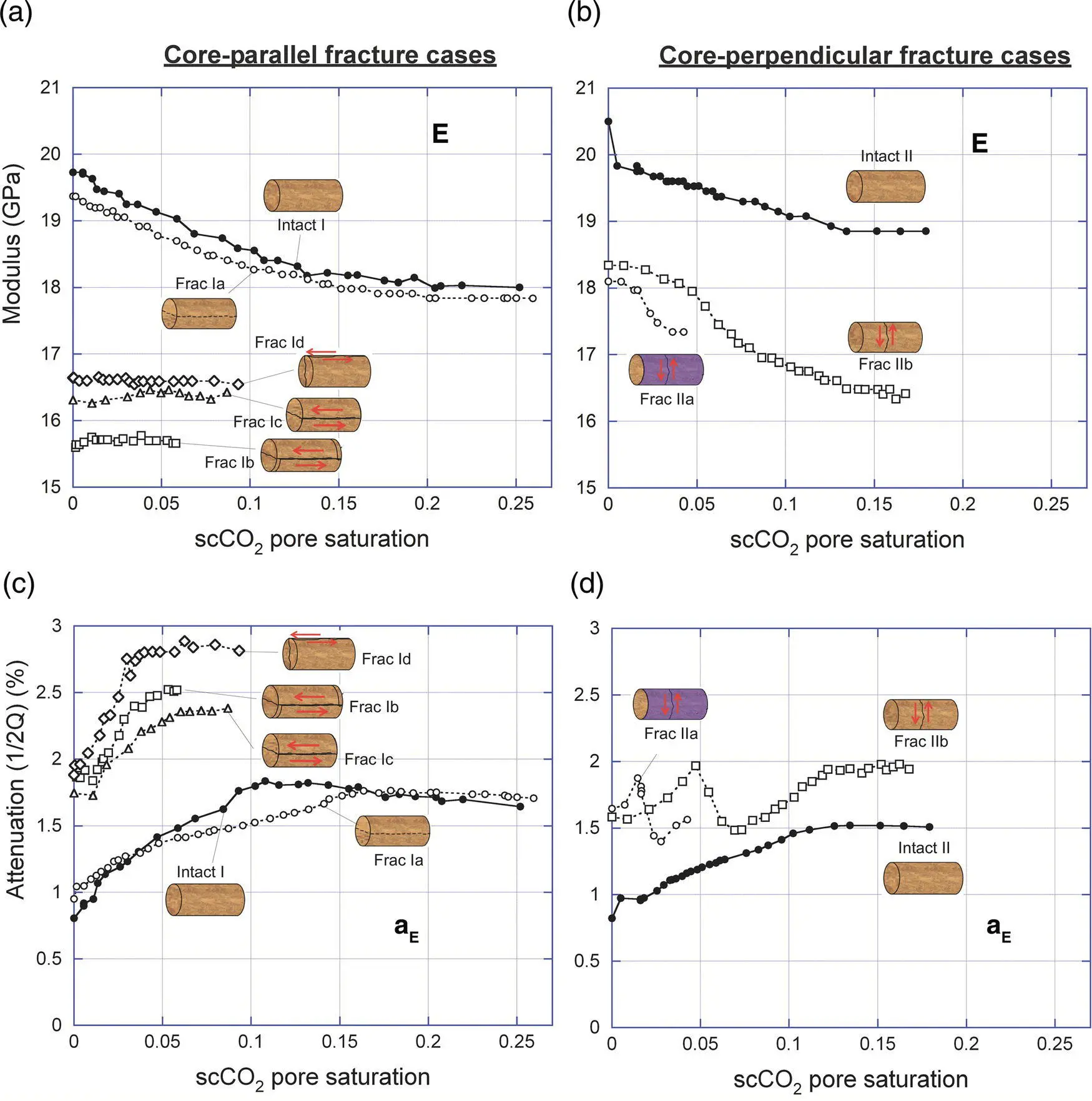
Figure 5.5 Young's modulus and related attenuations determined from SHRB tests during scCO 2injection experiments on Carbon Tan sandstone cores: (a) Carbon Tan #1 elastic moduli; (b) Carbon Tan #2 elastic moduli; (c) Carbon Tan #1 attenuations; (d) Carbon Tan #2 attenuations.
5.3.2. scCO 2Injection Tests
Seismic Responses
During our scCO 2injection tests, measured resonance frequencies were mostly in the range of 1.4–1.5 kHz for the longitudinal (Young's modulus) mode, and 780–930 Hz for the torsion (Shear modulus) mode. Young's modulus and related attenuation during scCO 2injection determined from the resonances are shown in Figure 5.5. For both core‐parallel (Carbon Tan #1 core) and core‐perpendicular (Carbon Tan #2 core) fracture cases, intact cores (Intact I and II) and the core with the mated fracture (Frac Ia) showed similar trends: monotonically decreasing Young's modulus with increasing CO 2saturation, and concomitant increasing attenuation with a rather poorly defined maximum. Core #2 showed less overall changes than Core #1, however, with smaller final scCO 2saturation of the pore space (Core #1: 25%–26%; Core #2: ~18%). X‐ray CT images of scCO 2invasion into the core (presented in section 5.3.2.2) indicate this may be attributed to different porosity distribution and bedding structure in the samples.
Frac Ib, Ic, and Id samples containing core‐parallel, sheared fractures (average aperture 0.54 mm, determined from X‐ray CT images) showed much smaller Young's and shear moduli than the intact core, which, interestingly, did not change during scCO 2injection. In contrast, attenuation increased monotonically until scCO 2broke through the core. The final scCO 2saturation was much smaller (7%–9.5%) than for the intact core, because of the fast‐passing effect of the open, permeable fracture.
For the samples Frac IIa and Frac IIb containing core‐perpendicular, sheared fractures (average aperture 0.26 mm), Young's modulus showed similar behavior as the intact sample, decreasing monotonically as scCO 2saturation increased. (Note that Frac IIa shows much smaller final scCO 2saturation compared with the core‐parallel cases and the Frac IIb, because the scCO 2fast passed along the Mylar layer.) However, upon close examination, the changes in the modulus exhibited more complexity. Unlike the intact sample's Young's modulus, which showed the most rapid changes at the beginning of the scCO 2injection (saturation <~10%), the Young's modulus of the fractured samples dropped most quickly at intermediate scCO 2saturations. Such differences in the behavior were even more prominent for the attenuation: in contrast to the smooth and more‐or‐less monotonic changes for the intact sample, the fractured samples showed a sharp peak in the attenuation followed by an abrupt decrease, and subsequent gradual increases.
Читать дальшеИнтервал:
Закладка:
Похожие книги на «Geophysical Monitoring for Geologic Carbon Storage»
Представляем Вашему вниманию похожие книги на «Geophysical Monitoring for Geologic Carbon Storage» списком для выбора. Мы отобрали схожую по названию и смыслу литературу в надежде предоставить читателям больше вариантов отыскать новые, интересные, ещё непрочитанные произведения.
Обсуждение, отзывы о книге «Geophysical Monitoring for Geologic Carbon Storage» и просто собственные мнения читателей. Оставьте ваши комментарии, напишите, что Вы думаете о произведении, его смысле или главных героях. Укажите что конкретно понравилось, а что нет, и почему Вы так считаете.
